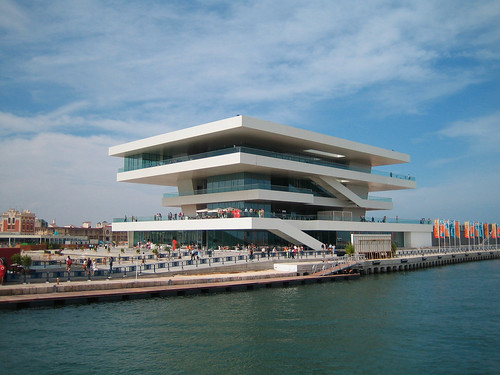

Do these buildings look the same to you? Look closely. They certainly look similar: floating slabs with glass railings ringing the building with exterior circulation, exposed stairs along the perimeter, and both situated right on the water. Maybe the first is just the concept rendering for the photo of the completed building. Right?
As in many aspects of life, in architecture there is indeed nothing new under the sun--or at least, not much! Architects are always looking at other architects' work and the built environment around them to get ideas about design. We are always looking at history--from ancient to recent--for inspiration. After all, how many mid-20th century glass office buildings were spawned in the wake of Mies van der Rohe's Seagram Building.
So now back to the big question: are these two images supposed to be of the same building?
The second image is a photograph of David Chipperfield's America's Cup Pavilion, completed in 2006 in Valencia, Spain. The first image is AART Architects VUC building, an adult education center slated for Haderslev, Denmark. I was stunned when I received my World Architecture News newsletter last month with the image of the VUC building--it immediately made me think of Chipperfield's project, and I wondered what the architects at AART were thinking as they proposed their project.
I suppose I have more questions to ask about intellectual property rights in architecture than answers to give, as I too am certain to be a culprit from time to time. After all, total innovation in architecture is difficult, probably unwise, and may not even make good architecture! So, here are a few points to ponder:
- Where do you draw the line between inspiration and plagiarism in architecture?
- Would it make a difference whether an architect is aware of the similarity in question or not? What if AART had never seen Chipperfield's project?
- Does it matter whether the architect of the original project is still alive?
- When does a similarity between two buildings turn into an actionable lawsuit?
- What if architects can clearly see the nuances between two projects but John Q. Public sees them as the same? When we talk design issues at work, my boss sometimes talks about the "mom test." I.e. would his mom "get it." Do we have to put this question on mom?
- What can we learn from other design or art fields? For instance, I heard a piece of music on the radio the other day that sounded so much like Aaron Copland that I thought it must have been a piece of his I had never heard before. When I discovered it was Julián Orbón instead, I looked him up on Wikipedia to find out he had studied under Copland. So is using a riff or some instrumentation of a mentor OK? Is this like taking a cue from Corbu in architecture? Or listening to your studio teacher in school?
I am inclined to think that some bit of similarity in architecture is entirely appropriate. But as for these two projects, I think they are a little too close for comfort.
I wonder if Chipperfield has seen AART's project?
No comments:
Post a Comment